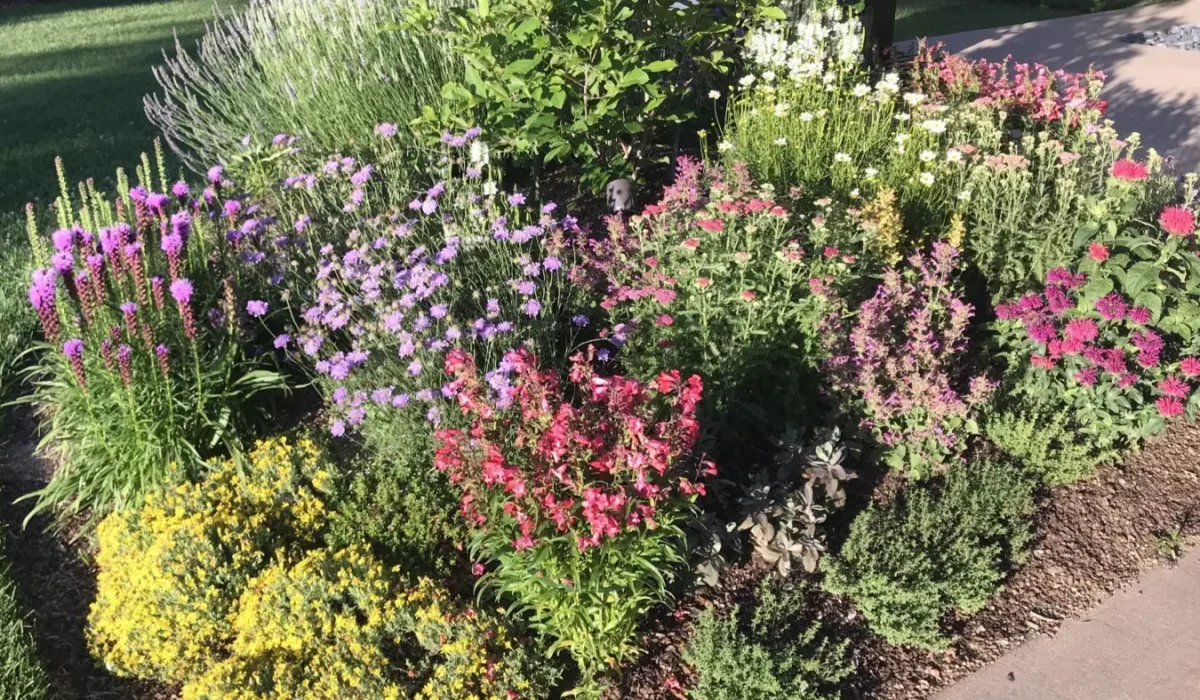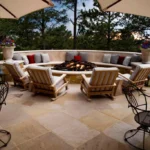Planning your Colorado home landscape: tips from the pros
Just about everyone in America wants to spend more time outdoors during the pandemic. But with all that extra time outside we become more aware of eyesores like overgrown shrubs, patches of weeds and dead grass (at least the weeds are green).
Some landscape changes are in order.
Landscape advice can range from “that’s never going to happen” to “why didn’t I think of that?” I think you will be in the latter group once you learn a few landscape tips from these outstanding Front Range professional landscape designers.
Address the bones of the garden
Alan Rollinger, a graduate of CSU’s Horticulture and Landscape program, recently retired after 50 years of design work along the Front Range and in other cities around the United States. He also taught landscape design and plant identification at the University of Colorado Denver and Denver Botanic Gardens.
Alan says planning the “bones of the garden” should be first on every DIY list. “Drainage issues and proper grading have to be addressed before one plant goes in.” This is the part of a landscape facelift or entire remodel where professionals should be considered so the project gets going on the right path.
Start with a call to the free location service 811 to have buried utilities flagged or painted. After grading and addressing drainage, focus on planning the larger hardscape features, like a pergola, fencing, water feature, outdoor kitchen, stonework, etc.
Make your landscape plan
Consider bringing in a professional for the irrigation system too, unless you plan to water by hand and hose.
“A house isn’t built without a plan,” said Trench. “Likewise, a master landscape plan is also recommended.”
If your house has a set of architectural plans, it should have the outside areas measured to scale. Make a couple of copies, then place translucent paper over the outdoor area and trace over the plans to show the landscape outline. Voila, you have a blank slate, a starting point to draw in the current landscape features, plants and trees.
Make a second drawing for your personal plan, which can include plants, a bocce court — anything you want.
If you need to start from scratch, create a site plan using graph paper; the common scale is 1 inch equals 8 feet. There are many “how-to-measure-landscape” YouTube videos and apps just a click away.
Make notes on the plans (using a pencil) of areas that need improvement and the placement of outdoor amenities. Make notes about how the sun moves over the space through the day and year; this will help later with plant choices.
Amend the soil
Typical soil in Colorado is like clay, and so dense a shovelful looks and feels like a block of smooth, dense Christmas fudge.
“Good soil preparation is the key to new plants getting established,” said Laurie Duke, owner of Meadowlark Garden Service in Elizabeth. “People have a tendency to overwater, which is not good in clay soils that drain slowly.”
Soil amendments go a long way to fluff up the soil and help break up clay soil for better drainage. Conversely, they bulk up quick-draining sandy soils. “Native plants are really popular,” Duke said. “Many are deer- and critter-resistant.”
Choose your plants, design your space
Next comes drawing in and choosing the plants, which for some folks is the fun part. If you are a self-learner or ambitious gardener with a good eye for design, by all means give it a go and see where your dream landscape plan takes you.
But if you are not comfortable with your own plant knowledge, bring in a pro. The outcome and the small monetary investment will net years of enjoyment and remove the frustration of a disorganized collection of plants that are not working. A knowledgeable, experienced landscape designer can help make your vision a reality, or at least get it started. They can address trouble spots like awkward access areas to side entrances or garages. Clever plantings to cover up neighborhood or alley eyesores are easily fixed by a professional’s expert eyes and plant prowess. Fees are generally affordable for a design plan. Already have your own plan? A pro may charge a small consultation fee to look over them; a second set of eyes is a good thing to avoid costly mistakes.
When planning on your own, ask yourself which existing plants are working? Which ones need to be shovel pruned (dug, removed, and added to the compost pile)? Is there too much shade for the roses now that the spruces and linden trees are 30-plus years old? Is the lawn growing sparse and looks tired? Has it become a pain to mow?
There are many landscape styles to consider (see the resources below for design ideas). Top on most lists is to have colorful flowering beds of non-stop bloom from March through October. Conversely, a lovely low-maintenance landscape to enjoy more with less work will ease your sometimes less-than-cooperative knees.
How about an herb bed to flavor up your dinners and iced tea? Maybe some grapevines and fruit trees for their sweet juicy peaches and crisp apples in late summer. Do not quit imagining just because you have no terra firma: A small, sunny patio can easily be transformed with vibrant potted trees and delicious summer tomatoes.
Like interior design, take into consideration color, balance, height, size and form. Color creates moods inside the house and out, i.e., hot colors of yellow, orange and red are bright and cheerful. A calm, serene feel comes from cool colors of greens, blues and purples. Color choices help outdoor spaces feel larger or smaller (cooler colors make spaces seem larger).
Harmony and balance
Knowing when to repeat plant colors at intervals can unify the design concept. And knowing how many of each plant to repeat is vital, since too many hot colors can easily overwhelm warm colors.
Felecia Ashby, owner of Cosmos Design, specializes in landscape design. Her experience with interior design brings “harmony and rhythm from the inside to outdoor spaces.” She cautions homeowners not to overdo a one-color palette.
“Too many blue flowering plants will appear faded and drab, the eye can’t discern without a counterbalance whether it is a light or dark color. Introduce another color so the blue stands out.”
Balancing plant heights and forms can be tricky. It seems intuitive to plant taller plants in the back of the border, but if the design is more freeform it might make sense to plant taller plants in wider spots or interspersed through the bed. Tying all the design elements together with plant textures may take some experimentation on the drawing. You might give free landscape apps like iScape or Home Outside a try.
Designers all say it is best to mix up and vary leaf textures. Incorporate crinkled, fuzzy or smooth-leafed plants next to each other, and contrast feathery flowers with bold, waxy or delicate blooms. And like repeating colors, repeating interesting textures really draws the eye to the landscape. You will like what you see.
More landscape tips from the pros
Alan Rollinger: “Look at the plant design objectively. What will it look like through the winter? Without sturdy structural plants like shrubs, trees and well-placed boulders or objects, it can look like a moonscape for seven months. Give plants room to grow. While letting plants get established, use annuals to fill in the gaps. Never plant a shrub in a small space when it wants to grow large; there’s too much shearing and improper pruning going on out there.”
Tom Trench: “Smaller 1- and 5-gallon-sized plants are much easier for the homeowner to plant. Bring in professionals for large tree planting.”
Laurie Duke: “Do your own research on plants and design. CSU and local nurseries are very helpful. Plant plants with similar soil and water requirements. Look for help from local professional organizations like the ALCC (Associated Landscape Contractors of Colorado), CNGA (Colorado Nursery and Greenhouse Association) and ISA (International Society of Arboriculture).
Felecia Ashby: “Bounce off your ideal landscape ideas with a professional; the right plan for the space can make the whole house sing. Projects can be completed in stages based on time and budget. Study and keep plant tags for sun requirements. Accept limitations in your setting: A full-shade plant that you love will not grow in a mostly sunny location.”
How to hire the right landscape professional
In the landscape world, people can be called different titles but offer similar or overlapping services. They include landscape contractor, landscape designer, landscape architect, professional gardener or horticulturist. Degrees and certification requirements vary among these titles.
Be warned: The landscape world includes many people who advertise garden services that include areas they may not necessarily be certified or properly bonded to engage in, including design work. A lawn-mowing service might offer landscape planting or tree pruning, but be sure to check all credentials, especially their arborist certification, and call their references.
A recommendation from a neighbor, friend or relative goes a long way, especially if you like their landscape. Ask to see photos of their recent work. Many designers offer a complementary or minimal introductory meeting fee (often this fee is credited toward the job). Some charge by the hour, and some by the job. Designers may do the design and installation with help from their crew, or they may recommend install companies.
Many will draw up the design plan so the homeowner can do the work as time and opportunities permit. Part of the enjoyment of creating a new or renovated landscape is adding personal touches or plants that may not be on the plan; designers expect and encourage homeowners to take part in making it their own space.


![Grass Growing Unevenly? [12 Causes and their Fixes] 2 1 1](https://milehighlifescape.com/wp-content/uploads/2023/10/1-1-150x150.png)